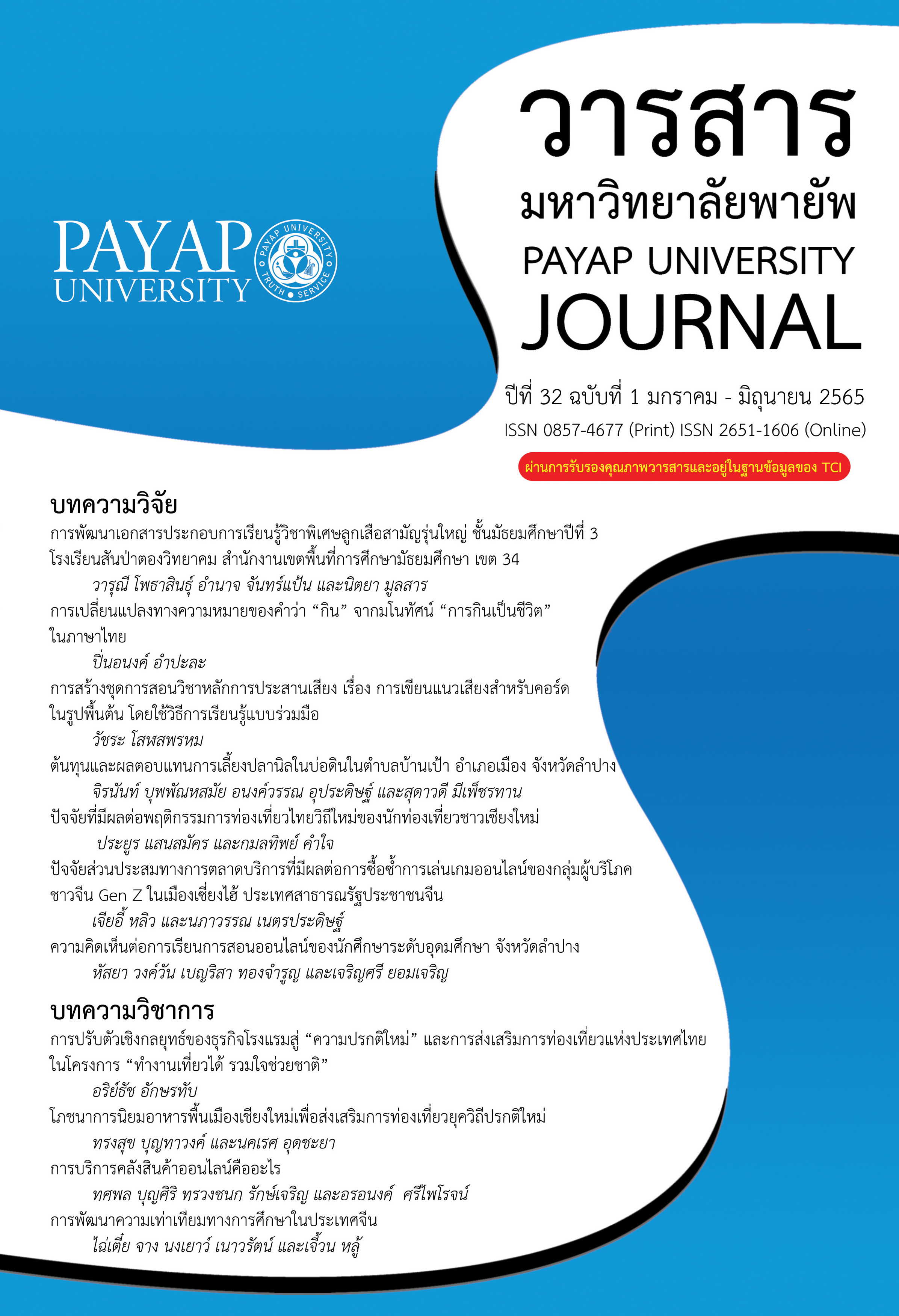ปัจจัยส่วนประสมทางการตลาดบริการที่มีผลต่อการซื้อซ้ำการเล่นเกมออนไลน์ของกลุ่มผู้บริโภคชาวจีน Gen Z ในเมืองเซี่ยงไฮ้ ประเทศสาธารณรัฐประชาชนจีน
Main Article Content
บทคัดย่อ
การศึกษาครั้งนี้ มีวัตถุประสงค์เพื่อศึกษาระดับความสำคัญของส่วนประสมทางการตลาดบริการ และการซื้อซ้ำการเล่นเกมออนไลน์ และเพื่อศึกษาส่วนประสมทางการตลาดบริการที่มีผลต่อการซื้อซ้ำการเล่นเกมออนไลน์ของกลุ่มผู้บริโภคชาวจีน Gen Z ในเมืองเซี่ยงไฮ้ ประเทศสาธารณรัฐประชาชนจีน กลุ่มตัวอย่างที่ใช้ในการศึกษา คือ กลุ่มผู้บริโภคชาวจีน Gen Z ในเมืองเซี่ยงไฮ้ ประเทศสาธารณรัฐประชาชนจีน จำนวน 385 คน เป็นการวิจัยเชิงสำรวจ เครื่องมือที่ใช้ในการศึกษาเป็นแบบสอบถาม สถิติที่ใช้ในการวิเคราะห์ข้อมูล ประกอบด้วย สถิติพรรณนา ได้แก่ ค่าความถี่ ร้อยละ ค่าเฉลี่ย ส่วนเบี่ยงเบนมาตรฐาน และสถิติอนุมาน ได้แก่ การถดถอยพหุคูณด้วยวิธี Enter
ผลการศึกษาพบว่า ส่วนประสมทางการตลาดบริการ และการซื้อซ้ำการเล่นเกมออนไลน์ของกลุ่มผู้บริโภคชาวจีน Gen Z ในเมืองเซี่ยงไฮ้ ประเทศสาธารณรัฐประชาชนจีน มีความสำคัญอยู่ในระดับมากทุกปัจจัย ส่วนการวิเคราะห์การถดถอยพหุคูณตัวแปรอิสระคือ ด้านผลิตภัณฑ์ ราคา ช่องทางจัดจำหน่าย การส่งเสริมการตลาด บุคลากร สิ่งนำเสนอทางกายภาพ และกระบวนการ ผลการวิเคราะห์พบว่า สิ่งนำเสนอทางกายภาพมีผลต่อการซื้อซ้ำการเล่นเกมออนไลน์ของกลุ่มผู้บริโภคชาวจีน Gen Z ในเมืองเซี่ยงไฮ้ ประเทศสาธารณรัฐประชาชนจีน อย่างมีนัยสำคัญทางสถิติที่ระดับ 0.01 และตัวแปรอิสระที่นำมาศึกษาสามารถทำนายผลการซื้อซ้ำการเล่นเกมออนไลน์ของกลุ่มผู้บริโภคชาวจีน Gen Z ในเมืองเซี่ยงไฮ้ ประเทศสาธารณรัฐประชาชนจีนได้ร้อยละ 56.90
Article Details
เอกสารอ้างอิง
กัลยา วานิชย์บัญชา. (2549). สถิติสำหรับงานวิจัย (พิมพ์ครั้งที่ 2). กรุงเทพฯ: จุฬาลงกรณ์มหาวิทยาลัย.
งามตา นามแสง และคนอื่น ๆ (2563). ส่วนประสมทางการตลาดบริการ และพฤติกรรมการตัดสินใจซื้อที่มีผลต่อความตั้งใจกลับมาซื้อซ้ำของลูกค้าที่ซื้อสินค้าในซุปเปอร์สโตร์ผ่านแอพพลิเคชั่น. วารสารการวิจัยการบริหารพัฒนา, 10(1), 11-20.
จารวี ยั่งยืน. (2549). สัมพันธภาพในครอบครัว สัมพันธภาพในกลุ่มเพื่อน และการเปิดรับสื่อเกมออนไลน์กับพฤติกรรมการเล่นเกมออนไลน์ของนักเรียนมัธยมศึกษาแห่งหนึ่งในเขตอำเภอเมือง จังหวัดสมุทรปราการ. วิทยานิพนธ์ปริญญามหาบัณฑิต คณะศิลปศาสตร์มหาวิทยาลัยเกษตรศาสตร์.
เชษฐภัทร พรหมชนะ. (2564). แนวคิดในการนำมาตรการทางกฎหมายมาใช้สำหรับการควบคุมเกมออนไลน์ในประเทศไทย. สืบค้นเมื่อ 25 พฤศจิกายน 2564. https://www.krisdika.go.th /data/activity/act13499.pdf.
ทศพล นาคศ (2555). ปัจจัยทางการตลาด และพฤติกรรมการเปิดรับเกมบน Facebook. วารสารวิชาการ, 4(3), 261-276.
ธนพัทธ์ เอมะบุตร. (2558). ปัจจัยที่มีอิทธิพลต่อการตัดสินใจเลือกเล่นเกมออนไลน์ของประชาชนในกรุงเทพมหานคร ปี 2558. การค้นคว้าอิสระปริญญามหาบัณฑิต คณะบริหารธุรกิจ มหาวิทยาลัยกรุงเทพ.
บุญชม ศรีสะอาด. (2553). การวิจัยเบื้องต้น (พิมพ์ครั้งที่ 8). กรุงเทพฯ: สุวีริยาสาส์น.
มนัสนันท์ หัตถศักดิ์. (2552). กระบวนการกลุ่ม (พิมพ์ครั้งที่ 7). ปทุมธานี: มหาวิทยาลัยกรุงเทพ.
วรพจน์ แสนสินรังษี และณักษ์ กุลิสร์ (2555). ปัจจัยทางด้านผลิตภัณฑ์และราคาที่มีความสัมพันธ์กับพฤติกรรมการเล่นเกมออนไลน์ DotA All Stars ของผู้บริโภคในเขตกรุงเทพมหานคร. วารสารบริหารธุรกิจศรีนครินทรวิโรฒ, 3(2), 80-97.
วรลัชญาน์ สิงห์ทองวรรณ์. (2562). การศึกษาความตั้งใจในการซื้อซ้ำไอเท็มในเกมออนไลน์ แบบเล่นตามบทบาท. วารสารระบบสารสนเทศด้านธุรกิจ, 5(3), 20-30.
ศศิวรรณ จันทร์เชื้อ. (2551). พฤติกรรมการเล่นเกมออนไลน์ของนักเรียนช่วงชั้นที่ 2 ในกรุงเทพมหานคร และจังหวัดนครสวรรค์. วิทยานิพนธ์ปริญญามหาบัณฑิต คณะศึกษาศาสตร์ มหาวิทยาลัยเกษตรศาสตร์.
สำนักงานส่งเสริมการค้าในต่างประเทศ. (2564). ตลาดอุตสาหกรรมเกมมือถือของจีน. กรุงเทพฯ: กระทรวงพาณิชย์.
เสรี วงษ์มณฑา. (2542). การวิเคราะห์พฤติกรรมผู้บริโภค. กรุงเทพฯ: ธีระฟิล์ม และไซเท็กซ์.
Armstrong, G. & Kotler, P. (2009). Marketing, and introduction (9th ed.). Upper Saddle River, N.J.: Pearson Prentice Hall.
Field, A. (2005). Discovering statistics using SPSS (2nd ed.). Thousand Oaks: Sage.
Gounaris, S., Dimitriadis, S., and Stathakopoulos, V. (2010). An examination of effects of service quality and satisfaction on customer's behavioral intention in e-shopping. Journal of service marketing, 24(2), 142–156.
Kim, C., Galliers, R. D., Shin, N., Han, J., and Kim, J. (2012). Factors influencing internet shopping value and customer repurchase intention. Electronic Commerce Research and Applications, 11(4), 374–387.
Kotler, P. (2000). Marketing management (The millennium ed.). Upper Saddle River, N.J.: Prentice - Hall.
Kotler, P. & Armstrong, G. (2004). Principles of marketing (10th ed.). Upper Saddle River, N.J.: Prentice - Hall.
Lee, F. C., Lee. J. C., and Lee, A. C. (2000). Statistics for business and financial economics. Singapore: World Scientific.
Lili, X. (2013). An empirical study on the influence of online consumer loyalty. Thesis of Master Degree. Changchun Education Institute.
McDonald, M. (2011). Creating powerful brands (4th ed.). Oxford: Elsevier.
Nunnally, J. C. (1978). Psychometric theory (2nd ed.). New York: McGraw-Hill.
Schroer, W. J. (2014). Generations X, Y, Z and the others. Retrieved November 24, 2021, from http://socialmarketing.org/archives/generations-xy-z-and-the-others/
Shiqing, S., (2019). Research on the influence of store product diversity on customer repeat purchase behavior. Master’s thesis. MinZu University of China.


